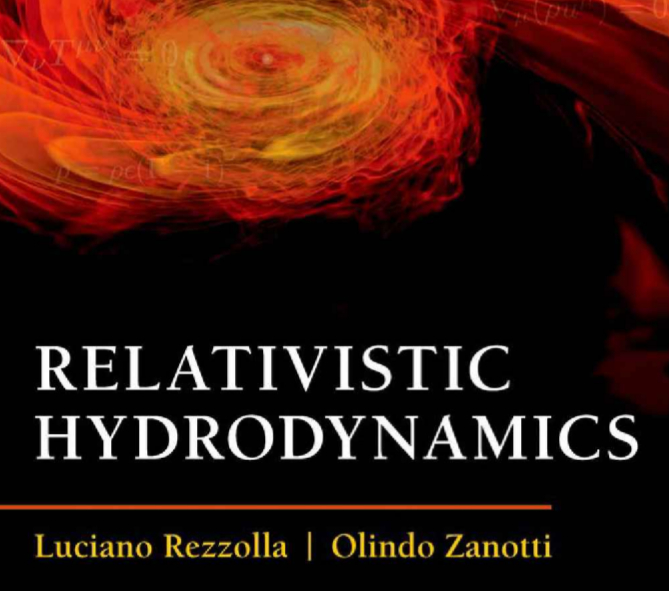Chapter II 第二章: Numerical General Relativity and Relativistic Hydrodynamics 数值广义相对论和相对论流体力学

L. Rezzolla and O. Zanotti, Relativistic Hydrodynamics, Oxford University Press (Oxford UK) 2013.
While Chapter I has been focussed on the basic groundings of GR and numerical relativity, the second and third chapter is meant for students with a good knowledge in advanced GR topics, like the (3+1)-split, the foliation of spacetime, the ADM-equations (and basics of the BSSNOK-, CCZ4-equations) and the Valencia formulation of relativistic hydrodynamics. Additionally, advanced computer skills and basic knowledge in Python programming is necessary.
In order to perform time dependent numerical simulations of mergers of compact stars or to simulate the evolution of a collapse of a neutron star to a black hole or to a quark star, we need to reformulate the Einstein and hydrodynamic equations. This reformulation, using the so called ($3+1$)-split, starts by slicing the 4-dimensional manifold ${\cal M}$ into 3-dimensional space-like hypersurfaces $\Sigma_t$. The space-time metric $g_{\mu\nu}$ is then also separated into a purely spatial metric $\gamma_{ij}$, a lapse function $\alpha$ and a shift vector $\beta_i$:
\[
\begin{equation}
g_{\mu\nu} ~=~
\begin{pmatrix}
-\alpha^2+\beta_i\beta^i & \beta_i \\
\beta_i & \gamma_{ij}
\end{pmatrix}
\end{equation}
\]
The lapse function $\alpha$ describes the difference between the coordinate time $t$ and the proper time of a fluid particle $\tau$ ($d\tau = \alpha~ dt$). The shift vector $\beta_i$ measures how the coordinates are shifted on the spatial slice if the fluid particle moves an infinitesimal time step further. By inserting this Ansatz of the metric into the Einstein equation one can reformulate the equations into a system of first order differential equations, the so called ADM equations. As the ADM equations are not well posed, the equations need to be further transformed. We will use the Baumgarte-Shapiro-Shibata-Nakamura-Oohara-Kojima (BSSNOK) formulation of general relativity (or alternatively the CCZ4 formulation) together with the relativistic hydrodynamical equations (formulated using the Valencia formulation) as the grounding equations in the computer program Einstein Toolkit. Using this program we will simulate several problems like the oscillations of a stable neutron star, the migration of an unstable neutron star to a stable configuration and the collapse of an unstable neutron star to a black hole. The appearance of the QCD - phase transition (the transition from confined hadronic to deconfined quark matter) will change the properties of neutron stars; eg. usually it is assumed that the loss of stability of a neutron star, exceeding its maximum mass, leads to the collapse into a black hole. However, realistic calculations within EOS's of QCD-motivated models show that a neutron star collapse could be stopped before the black hole forms. Within such a collapse scenario the neutron star would be transformed into a hybrid star with a deconfined quark matter phase at its inner core. At the end of this chapter a simulation will be presented which shows such a twin-star collapse.
The Computer Code "Einstein Toolkit" 程序:"爱因斯坦工具包"
Download the latest version of the Einstein Toolkit: Go on http://einsteintoolkit.org under Downloads
You need to have the following programs already installed on your Linux: sudo apt-get install build-essential perl gfortran g++ libmpich-dev openmpi-bin openmpi-doc libopenmpi-dev ...
Setup Simfactory (for help see http://simfactory.org/ ):
./simfactory/bin/sim setup
Build (compile) the Einstein Toolkit on e.g. a Linux Laptop (change ubuntu.cfg in Cactus/simfactory/mdb/optionlists/ according to your computer settings, e.g. see my ubuntu.cfg):
./simfactory/bin/sim build --thornlist ./manifest/einsteintoolkit.th --optionlist ./simfactory/mdb/optionlists/ubuntu.cfg
Create and run the first test simulation:
./simfactory/bin/sim create static_tov --parfile ./par/static_tov.par
./simfactory/bin/sim run static_tov --num-threads=2
Task 1: Migration of an unstable neutron star to a stable configuration
In this task, the migration of an unstable neutron star to its corresponding stable configuration will be simulated using the Einstein Toolkit (see NS_collapse.pdf for details). To compare your results, a selection of the output data can be found under the following link: output.zip. The detailed description of this task, the necessary parameter files and Mathematica notebooks for the visualisation of the output data can be downloaded under the following link: Task 1. The several files of the output data can be visualized using e.g.
Task 2: Collapse of an unstable neutron star to a black hole
In this task, the collapse of an unstable neutron star to a black hole will be simulated using the Einstein Toolkit (see NS_collapse.pdf for details). To compare your results, a selection of the output data can be found under the following link: output.zip. The detailed description of this task, the necessary parameter files and Mathematica notebooks for the visualisation of the output data can be downloaded under the following link: Task 2. The several files of the output data can be visualized using e.g.
Task 3: Radial oscillations of a stable neutron star
In this simulation, we learn how to extract oscillations of a neutron star using the Einstein Toolkit. We concentrate only on radial oscillations of a spherically symmetric compact star using a simple polytropic EOS and identify the eigenfrequencies of the oscillations (see TOV_oscillations.pdf for details). The detailed description of this task, the necessary parameter files and Mathematica notebooks for the visualisation of the output data can be downloaded under the following link: Task 3.
The twin star collapse
Collapse of an unstable neutron star to a hybrid quark star (
